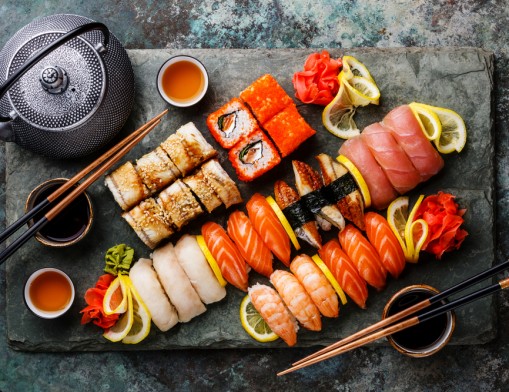
Sushi is a work of art, and appreciating the chef's creation is half the fun.
I would say I am a fan of sushi, but that really isn’t true. I am more of a sushi fangirl. Give me all the sushi. First of all, sushi is arguably the most adorable food. If a sushi chef has any degree of competence, it is highly instagrammable. As a person generally fond of snack foods, anything that falls in the dual appetizer-meal category is high on my faves list. If you’re a sushi novice, I’ve put together a few little tips for expanding your sushi horizons.
Know the lingo.
Trying to order sushi can be intimidating (shout out to anyone who ever tried to discreetly google “unagi” on your iPhone before the sake arrived). In fact, the only thing more intimidating than trying to navigate unfamiliar terminology is sitting down to eat with someone who inexplicably knows every Japanese term on the menu.
It is a common misconception that sushi is always raw fish. Sushi is just a blanket term for bite-sized food rolled in vinegared rice.
There are two main kinds of rolled sushi: maki and uramaki. All rolled sushi consists of rice and nori (seaweed) wrapped around other ingredients, typically fish and vegetables. Maki basically means any rolled sushi, typically with rice wrapped in nori. Uramaki means “inside-out roll” because the nori is on the inside of the rice. The other main food items on a sushi menu are typically sashimi (sliced raw fish) and nigiri (sliced raw fish served on rice). Other kinds of sushi exist in the world, but you can worry about those later on. You have to learn to crawl before you can learn to walk.
You probably know what wasabi is, but you may not know that another word for soy sauce is shoyu.
The only other thing you really need to know is the name of the fish you are ordering. Unagi is eel, tako is octopus. Ikura is salmon roe, masago is smelt roe. No one knows what a smelt is, but their eggs are orange and delicious. Sake is the Japanese word for salmon, maguro is tuna, and hamachi is yellowtail. Ebi is shrimp, kani is crab. There are many other items you might encounter, but if you learn these terms, you can order off the menu with some degree of competence.
If you’re wary about eating raw fish so far inland, set your mind at ease. Generally, most sushi restaurants in Tulsa have fresh fish flown in every two days or shipped overnight. Tuna comes from Honolulu, while most other fish comes from Los Angeles. Things like eel and octopus are flown frozen because they have to be shipped from Japan. Sushi chefs take pride in serving the best ingredients, so you never have to ask if the fish is fresh.
Watch the magic.
One of the best ways to enjoy sushi is to sit at the sushi bar and watch the masters work. Sushi chefs take great pride in what they do, and they enjoy their jobs. Much like eating sushi, sitting at the sushi bar is a sensory experience. Sushi stations are filled with fresh fish and ingredients your chef will be happy to explain if he or she gets time. Although they can be very busy, when they get a spare moment, sushi chefs are typically enthusiastic to talk about their craft and ingredients. Rolling sushi is highly skilled work, and most sushi chefs keep their own knives which are not only beyond sharp but can also be quite an investment.
Befriending the sushi chef can have other perks, too. They know about special items that may not be on the menu (I know a guy who makes special dessert sushi for my kids with fruit, whipped cream, and cinnamon), and they are endlessly creative if you want to try something unique from the chef’s imagination.
Tipping the chef is the best way to compliment the chef on his or her craftsmanship, but tipping at the sushi bar can be a little confusing because you will often have a server as well who brings drinks, salads, and food from the kitchen. Tip the server what you typically would. Sushi chefs earn an hourly wage, so any tips they earn are a token of appreciation. Sushi chefs do depend on occasional tips as part of their salaries, but do not rely on them as their main source of income the way servers do. In other words, anything you give them is very appreciated.
Eat like an expert.
Even after eating sushi for years, I still struggle with eating it the way it’s intended, so I don’t. Sushi is meant to be eaten in single bites, which is why sushi has to be rolled very tightly and served in small pieces. With each bite, you taste the fresh ingredients, the flavors blending together perfectly.
The problem is that often, those bites aren’t really very bite-sized, and there is just no graceful way to shove an entire piece of sushi in your mouth without looking like a giraffe at feeding time. Try cutting it in half or eating it in two bites and you’re likely to end up wearing rice.
While technically it is super gauche to eat sushi in more than one bite, American-made sushi is usually much bigger than the rolls served in Japan, and chances are good you’ll be eating it surrounded by all manner of sushi criminals: wasabi-soy soup makers, fork eaters, and even that guy who puts the ginger on top of his crunchy roll. My advice is to eat it however you can get it in your mouth.
It is also perfectly acceptable to eat with your fingers. In fact, sushi exists because a long time ago, workers needed a bite-sized lunch that they could eat on the go. Eating sushi with your hands allows you to better appreciate the texture and temperature of the rolls. I don’t bother with chopsticks at all, but if you do, just please don’t rub your chopsticks together. They don’t need it, and the sushi chefs are probably laughing on the inside.
It is also a no-no to dip the rice side of nigiri into the soy sauce. If you dip the fish, you get the perfect portion for flavor enhancement, but if you dip the rice side, your rice soaks up the soy sauce like a little sushi sponge and turns your perfect bite of salmon or tuna into an oil-colored sodium bomb. Worse, your soy sauce dish becomes a wasteland of errant rice soldiers drifting aimlessly in an ocean of MSG.
When it comes to wasabi, just remember that if you add too much, you can’t taste the sweetness of the fish.
If you still aren’t sure what the ginger is all about, it is for cleansing your palate between bites. I regularly subject my taste buds to constant sensory assault with everything from McDonald’s burgers to shamefully cheap wine, so my palate is like the Coachella of flavor experiences on any given day, but if you are a purist and want to get the most out of your sushi experience, use the ginger.
The biggest sushi etiquette you need to worry about has to do with appreciating the food you are eating for what it is: art created by an artisan. When you dunk your sushi in a soy sauce bath before you even try it, you are not giving yourself the opportunity to experience the hard work your chef has put into preparing your meal. As long as you are taking time to appreciate the food and share that appreciation with your chef, you really don’t have to worry about whether you are eating the right way.
Sharing is caring.
Eating family style is the best way to try many different rolls, and it can be the most fun way to break bread with your tribe. But when you eat from the communal candy roll, turn your chopsticks backward so the blunt end is touching the sushi. This keeps your germs out of contact with everyone else’s food.
It is also culturally insensitive to pass food between chopsticks, as this mimics a Japanese funeral ritual. Of course, all of these issues of food-sharing etiquette could just be avoided if you take my advice and eat with your fingers.
There is no wrong way to sushi.
Technically, at least. People are doing weird things with sushi in this postmodern age. Many completely legitimate sushi restaurants offer the east Asian answer to the Monte Cristo, deep fried sushi rolls. There is an entire subreddit dedicated to the mad science of bizarre sushi creations at www.reddit.com/r/SushiAbomination/.
Sushi burritos, spam sushi, and sushi “burgers” are all actual things that exist in the world. You can even order a “sushi bazooka,” a device resembling a piece of PVC pipe for rolling sushi and pushing it out in much the same way your Play-Doh pasta maker did when you were a kid. And some of the sushi rolls you can get at grocery stores are actually pretty decent. Target has a chef who comes in to make their rolls fresh every morning, which I have been known to shove in my face while filling my cart with everything except the one thing I actually came to Target for.
Tulsa has plenty of great sushi spots, so grab your soymate and let the good times roll. It would make miso happy.
See more about Sushi Crash Course:
https://www.valuenews.com/sushi-crash-course-news-article_4387

